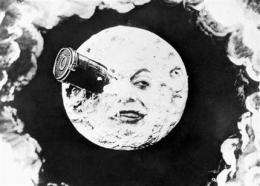Moonstruck: Making one giant thud for mankind

(AP) -- For as long as man has looked up, the moon has inspired romance, poetry and songs. Man also likes blowing things up. Now we get to do both - in the name of science.
The aim of Friday's deliberate crash of two unmanned NASA spacecraft into the moon is to see if they can kick up some ice. It is the 20th lunar crash, most of them done on purpose, since the Russians first did it 50 years ago last month.
And that doesn't count the eight times we tried and somehow missed the moon or couldn't get off the ground.
For more than a century, the idea of Earthlings taking a swipe at the moon has permeated popular culture. The most enduring image is from the 1902 classic movie, "A Trip to the Moon," in which a bullet-like rocket wincingly lodges in the eye of the man in the moon.
As much as we like to gaze at the moon, we like stirring things up even more. It's the specialty of the hit show "Mythbusters" and the aptly named show "Destroyed in Seconds."
Friday's first smack: a 2.2-ton empty rocket stage crashing into the moon at twice the speed of a bullet, equal to the power of 1.5 tons of TNT, followed four minutes later with a smaller hit.
For those fearing that the crashes like Friday's could cause the moon to shift its orbit or send huge chunks back to Earth, agency scientists have some words of comfort.
They say such crashes have no more effect on the moon than an eyelash dropping on a jet. Sure the impact may seem big, but so is the moon.
This also is something that happens four times a month to the moon, said Dan Andrews, the head of this NASA lunar crash mission. The only difference is that those hits are from naturally occurring space rocks.
No one personifies the blow-'em-up-in-the-name-of-science more than Brown University geologist Peter Schultz, a scientist who worked on NASA's similar purposeful crash into a comet in 2005. He's a regular cosmic crasher in the name of science - and jollies.
"Whenever these things happen, the first thing that comes out of your mouth is 'Geez,'" Schultz said. "I've got the neatest job in the world."
It's human nature to blow things up and dissect what happens, Schultz said Thursday from the Vertical Gun Range at NASA's Ames Research Center.
"There's a reason you drop pumpkins off a 30-story building," he told The Associated Press.
He won't say whether he's done that - but he has shot eggs out of jet engines into the ground to see what happens to the shells. And then there's this don't-do-this-at-home moment from his boyhood: He put a firecracker into an ant mound and took pictures of the flying ants during the explosion.
Schultz later got a telescope and fell in love with the moon and its craters. He planned to look at the crash with spacecraft cameras capable of 1 million frames per second - getting millisecond-by-millisecond details of the violence.
NASA's plan, which often mistakenly was called "bombing the moon," has generated lots of late-night humor and even some outrage.
David Letterman, who has dropped watermelons off Manhattan rooftops, has riffed on it repeatedly. He speculated on a counterattack by the moon with his own NASA-like animation and then compared it to the U.S. war in Iraq, as an attack-first, ask-questions-later scenario.
Others aren't completely joking about their concerns.
Novelist Amy Ephron doesn't understand the hoopla surrounding NASA's moon crash and wondered whether the public would be as excited about the mission if a country like Iran were in charge.
Ephron created a "Help Save the Moon" Twitter campaign - part tongue-in-cheek and part serious - to prevent future lunar dustups and to start a debate about who owns the moon.
"I really am a pacifist. I don't like the idea of sending a missile to Afghanistan or to Iraq or to the moon," said Ephron, while stressing that she's not against space exploration.
Still the moon beckons as an inviting target.
NASA's Andrews said his 12-year-old son was out gazing at the sky a couple months ago and came back and told him: "Look Dad, it's taunting you."
---
On the Net
NASA's moon crash mission: http://www.nasa.gov/mission(underscore)pages/LCROSS/main/index.html
Save the moon Twitter site: http://twitter.com/helpsavethemoon
©2009 The Associated Press. All rights reserved. This material may not be published, broadcast, rewritten or redistributed.

















